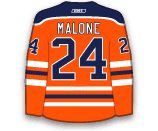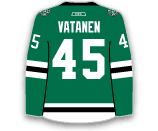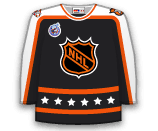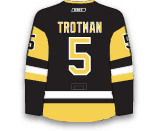Porter hadn't dressed since December 21 and has only registered one assist with a minus-5 rating in 12 games with the Sabres.

Porter hadn't dressed since December 21 and has only registered one assist with a minus-5 rating in 12 games with the Sabres.

McNabb played in seven games during his most recent call-up. He failed to record a points and was a plus-1 with seven shots and 14 hits. He returns to Rochester where he has 15 points (3G / 12A) in 20 games.

Beck has not recorded a point in two games with the Predators this season but has played very well in Milwaukee. In 35 games in the AHL he has racked up 11 goals and 16 assists (27 points).

Malone has recorded two assists in 15 games with the Avalanche this season, but will return to Lake Erie where he has eight points (4G / 4A) in 15 games. His assignment means that Alex Tanguay is ready too come off of IR.

Doherty is a 22-year-old defenseman who was selected in the second round (57th overall) in 2009. He is currently in his third full season with Worcester where he has eight points (3G / 5A) in 37 games. He has totalled four goals and 20 assists (24 points) in 140 games with Worcester. He was likely recalled as blueline insurance with Scott Hannan on IR.

Gustafsson had been recalled because Niklas Backstrom was sidelined for a couple of days after receiving a cortisone shot. Gustafsson returns to the AHL where he is 7-7-1 with a 2.75 GAA and .910 SV%.

Vatanen was the 106th overall pick in 2009 (4th round). Vatanen recorded 14 points (6G / 8A) in 39 games with the Ducks this season. He has been sent down because of the great blueline depth in Anaheim, he is simply a victim of a numbers game and will see a lot more playing time in Norfolk.

Schmidt has appeared in 28 games with the Capitals this season, he has two goals and four assists. In 16 games with Hershey he had seven points (1G / 6A).

Oleksy had been a healthy scratch for the last six games, he had 10 points (2G / 8A) in 33 games for the Capitals this season. Nate Schmidt has been recalled with Olesky going down.

The recall is Da Costa's second stint with the big club after making the team out of training camp. Da Costa began the 2013-14 season with Ottawa and appeared in four of the club’s first seven games. During that span he was held scoreless and registered two penalty minutes. In 37 AHL games this season, Da Costa has scored 12 goals and added 25 assists for 37 points and a plus-11 rating. Da Costa’s 37 points leave him seventh in league scoring. He will be in the lineup tonight on a line with Colin Greening and Chris Neil.
Trotman played 13:19 while recording one shot and two hits in the Bruins loss on Monday. Trotman has skated in 32 games for Providence this season and recorded four goals and seven assists and a team best plus-13 rating.

Sbisa has been out since November 22 after undergoing surgery to repair a torn ligament in his hand. With his conditioning stint behind him, he should be ready to slide back into the lineup this week. The 23-year-old has one assist in nine games this season.

Josh Harding is still out with an illness while Niklas Backstrom will be off of the ice for the next few days after receiving a cortisone shot for a nagging lower-body injury. Gustafsson has been recalled to back up Darcy Kuemper on Tuesday night in Dallas.

Despite starting 14 of their last 20 games, Grubauer was pulled in each of his last two starts and has been reassigned. This is a tough break for owners who invested on him, but if you did, evaluate the waiver wire options because Caps goalies are terribly risky right now.

Smith has recorded one assist in 14 games with the Flames this season. He returns to the AHL where he has spent five games with Abbotsford this season, he has registered just one goal with the Heat. This clears space for Kris Russell to return from IR this week.

Blum recorded no points and two shots in four games with the Wild. He will return to Iowa and play tonight and could find himself recalled shortly. However this could also suggest that Jared Spurgeon is nearing activation from IR.

With David Clarkson and Frazer McLaren recently placed on IR the Leafs were down to just 11 forwards. Bodie is now their 12th forward and will likely be in the lineup tonight vs. the Habs, unless they decide to go with seven defensemen.

This is the second time this season that Klesla has cleared waivers. He The former 4th overall pick has just four points (1G / 3A) in 25 games with the Coyotes this season. He returns to the AHL where he has one goal and one assist in six games.
Sbisa has been out since November 22 with a hand injury, but has progressed to the point where he can play with Norfolk until he is back in game shape, at which point he will be recalled by the Ducks.

With Jonas Hiller back from his illness, the Ducks have reassigned Gibson to Norfolk. His NHL debut will have to wait as he heads back to the AHL were he is 11-9-3 with a 2.61 GAA and .915 SV% this season.
